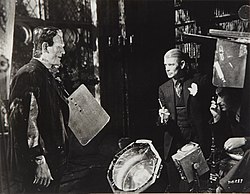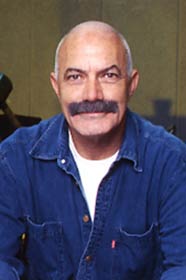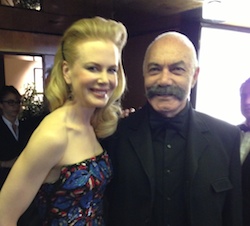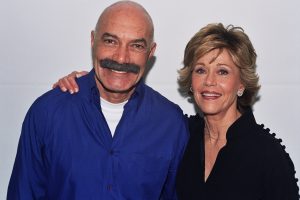James Whale (July 22, 1889–May 29, 1957), the English film and theater director and actor, spent the best part of his career in Hollywood.
He is best remembered for his horror films: Frankenstein (1931), The Old Dark House (1932), The Invisible Man (1933) and Bride of Frankenstein (1935), all considered classics. Whale also directed films in other genres, including the 1936 version of the musical Show Boat.
Whale was born into a large family in Dudley, Worcestershire (the Metropolitan Borough of Dudley). He discovered his artistic talent early on and studied art.
With the outbreak of World War I, he enlisted in the British Army and became an officer. He was captured by the Germans and during his time as a prisoner of war he realised he was interested in drama. Following his release at the end of the war he became an actor, set designer and director. His success directing the 1928 play Journey’s End led to his move to the US, first to direct the play on Broadway and then to Hollywood to direct films.
He lived in Hollywood for the rest of his life, most of that time with his longtime romantic partner, producer David Lewis.
Apart from Journey’s End (1930), which was released by Tiffany Films, and Hell’s Angels (1930), released by United Artists, he directed dozen films for Universal Pictures between 1931 and 1937, developing a style that was influenced by German Expressionism and a highly mobile camera.
At the height of his career, Whale directed The Road Back (1937), a sequel to All Quiet on the Western Front. Studio interference, spurred by political pressure from Nazi Germany, led to the film’s being altered from Whale’s vision, and it was a critical failure.
Several box-office disappointments followed and, while he would make one final short in 1950, by 1941 his film career was over. He continued to direct for the stage and also rediscovered love for painting and traveling. His investments made him wealthy and he lived a comfortably until suffering strokes in 1956 that robbed him of vigor and left him in pain.
He took his own life on May 29, 1957 by drowning himself in his swimming pool.
Whale was openly gay, something that was very rare in the 1920s and 1930s. As knowledge of his sexual orientation has become widespread, some of his films, Bride of Frankenstein in particular, have been interpreted as having gay subtext and it has been claimed that his refusal to remain in the closet led to the end of his career. Others have contended that his retirement was provoked by a succession of poorly received projects with which Whale was growing personally dissatisfied (particularly deleterious to his career was The Road Back).
Whale was born in Dudley, Worcestershire, in the Black Country, the sixth of seven children of William, a blast furnaceman, and Sarah, a nurse.
He attended Kates Hill Board School, followed by Bayliss Charity School and Dudley Blue Coat School. His attendance stopped in his teenage years, because the cost was prohibitive and his labor was needed to help support the family. Thought not physically strong enough to follow brothers into the local heavy industries, Whale started work as a cobbler, reclaiming the nails he recovered from replaced soles and selling them for scrap for extra money.
He had some artistic ability and earned additional money lettering signs and price tags for his neighbors. He used his additional income to pay for evening classes at the Dudley School of Arts and Crafts.
World War I broke out in August 1914. Although Whale had little interest in politics, he realized that conscription was inevitable, so he voluntarily enlisted (just before it was introduced), into the British Army’s Inns of Court Officer Training Corps in October 1915, and was stationed at Bristol. In July 1916, he was commissioned as second lieutenant into the Worcestershire Regiment
He was taken prisoner of war in battle on the Western Front in Flanders in August 1917, and was held at Holzminden Officers’ Camp, where he remained until the war’s end, being repatriated to England in December 1918.
While imprisoned he became involved, as actor, writer, producer and designer, in amateur productions in the camp as “a source of pleasure and amusement.” He also developed talent for poker, and after the war he cashed in the chits and IOUs from fellow prisoners that he had amassed in gambling to provide himself with money for his civilian life.
Career
Journey’s End
After the armistice, he returned to Birmingham and tried to find work as cartoonist. He sold cartoons to the Bystander in 1919 but was unable to secure a position. Later that year he embarked on a professional stage career. Under the tutelage of actor-manager Nigel Playfair, he worked as actor, set designer, stage manager, and director.
In 1922, while with Playfair, he met and dated Doris Zinkeisen, despite being openly gay man. They were engaged in 1924, but by 1925 the engagement was off.
In 1928 Whale was offered to direct R. C. Sherriff’s then-unknown play “Journey’s End” for the Incorporated Stage Society, a theatre society that mounted private Sunday performances. Set over a four-day period in March 1918 in the trenches at Saint-Quentin, France, Journey’s End depicts the experiences of the officers of a British infantry company in World War I. The conflict is between Capt. Stanhope, the company commander, and Lt. Raleigh, the brother of Stanhope’s fiancée.
Whale offered the part of Stanhope to then barely known Laurence Olivier. Olivier initially declined the role, but after meeting the playwright agreed. Maurice Evans was cast as Raleigh. The play was well received and transferred to the Savoy Theatre in the West End, on January 21, 1929.
Colin Clive was in the lead role, after Olivier accepted took the lead in “Beau Geste.” The play was tremendous success, with critics effusive in their praise and audiences sometimes sitting in stunned silence following its conclusion only to burst into thunderous ovations.
As Whale biographer James Curtis wrote, the play “managed to coalesce, at the right time and in the right manner, the impressions of a whole generation of men who were in the war and who had found it impossible, through words or deeds, to adequately express to their friends and families what the trenches had been like.”
After 3 weeks at the Savoy, Journey’s End transferred to the Prince of Wales Theatre, where it ran for the next two years.

The success of the various productions of Journey’s End attracted movie producers. Movies were then making the transition from silent to talking, and producers were interested in hiring actors and directors with experience with dialogue.
Whale traveled to Hollywood in 1929 and signed contract with Paramount. He was assigned as “dialogue director” for The Love Doctor (1929). He completed work on the film in 15 days, after which his contract expired.
Around this time that he met David Lewis, who would becme his personal companion.
Whale was hired by independent producer and aviation pioneer Howard Hughes, who planned to turn the silent version Hell’s Angels (1930) into a talkie. Whale directed the dialogue sequences. When his work for Hughes was completed, he headed to Chicago to direct another production of Journey’s End.
Having purchased the film rights to Journey’s End, British producers Michael Balcon and Thomas Welsh hired Whale to direct the film. They partnered with small American studio, Tiffany-Stahl, to shoot in New York. Colin Clive reprised his role as Stanhope, and David Manners was cast as Raleigh. Filming got underway on December 6, 1929 and wrapped on January 22, 1930. Journey’s End was released in Britain April 14, and a day later in the US. The film was tremendous critical and commercial success in bith countries.
Also in 1933 Whale directed the romantic comedy By Candlelight which gained good reviews and was modest box office hit.
In 1934, he directed One More River, adaptation of the novel of the same name by John Galsworthy. The film concers a woman desperate to escape her abusive marriage to a member of British aristocracy. This was the first of Whale’s films for which Production Code approval was required and Universal had difficulties securing that approval because of sexual sadism implicit in the husband’s abusive behavior.

Universal Studios signed Whale to 5-year contract in 1931 and his first project was Waterloo Bridge. Based on the Broadway play by Robert E. Sherwood, the film stars Mae Clarke as Myra, a chorus girl in WWI London who becomes a prostitute. It too was a critical and popular success.
In 1931, Universal chief Carl Laemmle Jr. offered Whale to choose any property the studio owned. He chose Frankenstein, because he wanted to make something other than war picture. While Mary Shelley’s 1818 novel Frankenstein, or The Modern Prometheus, was in the public domain, Universal owned the filming rights to a stage adaptation by Peggy Webling.
Whale cast Colin Clive as Henry Frankenstein and Mae Clarke as his fiancée Elizabeth. For the Monster, he cast the little known Boris Karloff, who had experience in supporting roles. Shooting began on August 24, 1931 and wrapped on October 3. Previews were held October 29, with wide release on November 21. Frankenstein was instant hit with critics and the public. The film received glowing reviews and shattered box office records in the US, earning $12 million on first release.
The Impatient Maiden made little impression but The Old Dark House, starring Karloff and Charles Laughton, is credited with reinventing the “dark house” subgenre of horror films. Thought lost for some years, a print was found by filmmaker Curtis Harrington in the Universal vaults in 1968. It was restored by George Eastman House, and released on Blu-ray in 2017.
Whale’s next film was The Kiss Before the Mirror (1933), a critical success but box-office failure.
He returned to horror with The Invisible Man (1933). Shot from a script approved by H. G. Wells, the film blended horror with humor and visual effects.

The film critical and box office success, earning some $2 million for Universal by 1943. Lauded as “the greatest of Universal’s gothic horror,” Bride is hailed as Whale’s masterpiece.
With the success of Bride, Laemmle was eager for Whale to direct Dracula’s Daughter (1936), the sequel to Universal’s first big horror hit of the sound era. Whale, wary of doing two horror films in a row and concerned that directing Dracula’s Daughter could interfere with his plans the first all-sound version of Show Boat (previously filmed as a part-talkie by Harry A. Pollard), instead convinced Laemmle to buy the rights to a novel called The Hangover Murders.
The novel is a comedy-mystery in the style of The Thin Man, about a group of friends so drunk the night one of them was murdered that none can remember anything. Retitled Remember Last Night? the film was one of Whale’s personal favorites, but met with divided reviews and commercial uninterest.

Whale directed Show Boat (1936), gathering from the stage production Helen Morgan, Paul Robeson, Charles Winninger, Sammy White, conductor Victor Baravalle, orchestrator Robert Russell Bennett, and, as Magnolia, Irene Dunne, who believed that Whale was the wrong director for the piece.
The 1936 version of Show Boat, adapted from the original stage production, is the definitive film version of the musical by many critics, but it became unavailable after the 1951 remake.
Show Boat was the last of Whale’s films produced under the Laemmle family. The studio was now bankrupt, and the Laemmles lost control to J. Cheever Cowdin, head of the Standard Capital Corporation, and Charles R. Rogers, installed in Laemmle’s old job.
Whale’s career went into sharp decline after the release of The Road Back (1937). The sequel to Erich Maria Remarque’s All Quiet on the Western Front, which Universal had filmed in 1930, the novel and film follow the lives of young German men who have returned from the trenches of World War I and their struggles to re-integrate into society.
When the Los Angeles consul for Nazi Germany, Georg Gyssling, learned that the film was in production, he protested to PCA enforcer Joseph Breen, arguing that the film gave an “untrue and distorted picture of the German people.” Gyssling met Whale, but nothing came of it. Gyssling then sent letters to the cast, threatening that participation in the film might lead to difficulties in obtaining German filming permits for them and for anyone associated in a film with them. While the low volume of business conducted by Universal in Germany made such threats largely hollow, the State Department, under pressure from the Hollywood Anti-Nazi League and the Screen Actors Guild, stepped in and the German government backed down.Whale’s original cut of the film was given generally positive reviews, but between preview screenings and the film’s release, Rogers capitulated to the Germans, ordering that cuts and additional scenes be shot and inserted. Whale was furious,mand the altered film was banned in Germany anyway. The Germans persuaded China, Greece, Italy and Switzerland to ban the film.
After the debacle of The Road Back, Charles Rogers tried to get annull his contract with Whale; Whale refused. Rogers then assigned him to B-movies to run out his contractual obligation.
With the outbreak of World War II, Whale volunteered his services to make a training film for the US Army. He shot the film, “Personnel Placement,” in the Army, in February 1942. In association with actress Claire DuBrey, he created the Brentwood Service Players, took over a 100–seat theatre. Sixty seats were provided free of charge to service personnel; the remaining were sold to the public, with the box office proceeds donated to wartime charities. The group expanded to the Playtime Theatre during the summer, where a series of shows ran through October.
Whale returned to Broadway in 1944 to direct the psychological thriller “Hand in Glove.” It was his first return to Broadway since his failed “One, Two, Three!” in 1930. Hand in Glove fared no better, running only 40 performances.
Whale directed his final film in 1950, a short based on William Saroyan one-act play “Hello Out There.” The film, financed by supermarket heir Huntington Hartford, was about a man in a Texas jail falsely accused of rape and the woman who cleans the jail. Hartford intended the short to be part of anthology film along the lines of Quartet. However, attempts to find short fiction companion were unsuccessful and Hello Out There was never commercially released.
Whale’s last professional engagement was directing “Pagan in the Parlour,” farce about two New England spinster sisters, visited by a Polynesian whom their father, when shipwrecked years earlier, had married.
The production was mounted in Pasadena for 2 weeks in 1951. Plans were made to take it to New York, but Whale suggested taking the play to London first, and to tour the art museums of Europe. In France he renewed his acquaintanceship with Curtis Harrington, whom he had met in 1947, who took him to some gay bars. At one, he met bartender named Pierre Foegel, age 25. Whale, then 62, was smitten with the youngser and hired him as chauffeur.
A provincial tour of Pagan in the Parlour began in September 1952. However, Hermione Baddeley, starring in the play as the cannibal “Noo-ga,” was drinking heavily and engaged in bizarre antics and disrupting performances. Because her contract stipulated that she could not be replaced, the producers were forced to close the show.
Filmography (1930-1941) 21 features
Journey’s End, 1930, directorial debut
Hell’s Angels, 1930 (only dialogue)
Waterloo Bridge, 1931
Frankenstein, 1931
The Impatient Maiden 1932
The Old Dark House 1932
The Kiss Before the Mirror 1933
The Invisible Man 1933
By Candlelight, 1933
One More River 1934
(One of first films subjected to Production Code censorship)
Bride of Frankenstein, 1935
Remember Last Night? 1935
Show Boat, 1936
The Road Back, 1937
The Great Garrick, 1937
Port of Seven Seas, 1938
Sinners in Paradise, 1938
Wives Under Suspicion, 1938
The Man in the Iron Mask, 1939
Green Hell, 1940
They Dare Not Love, 1941, final film










